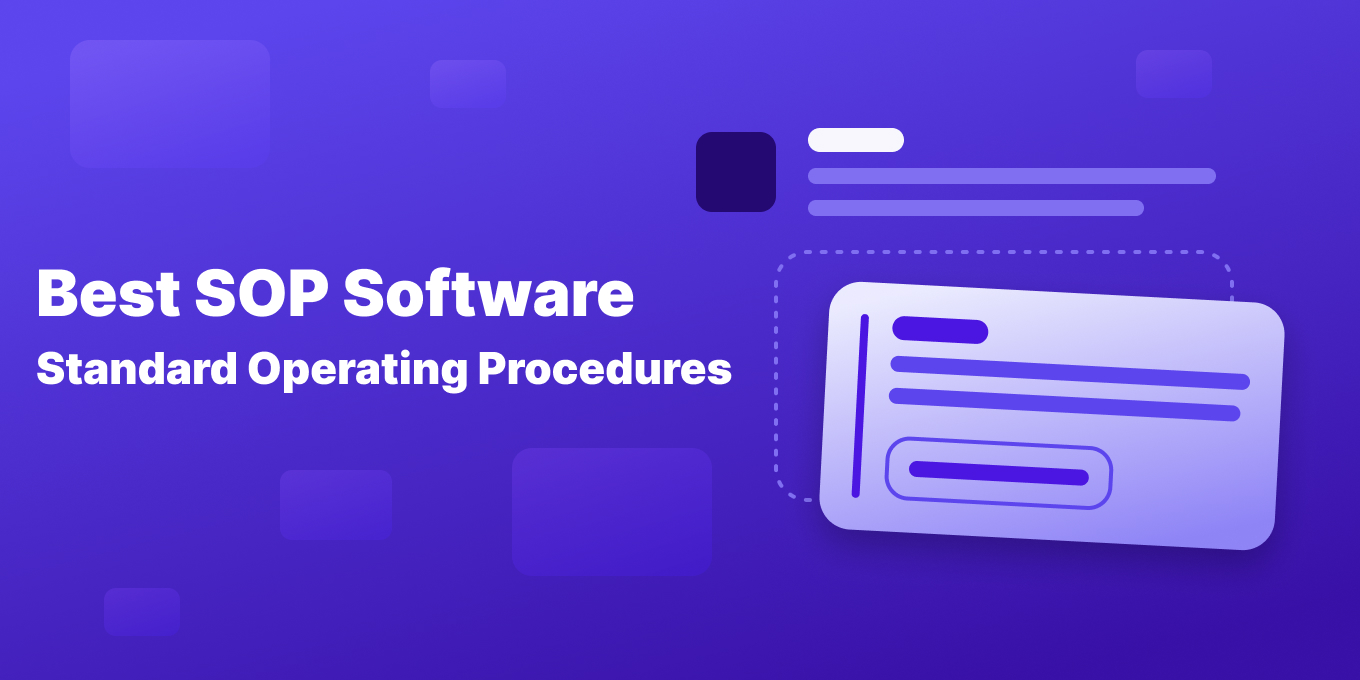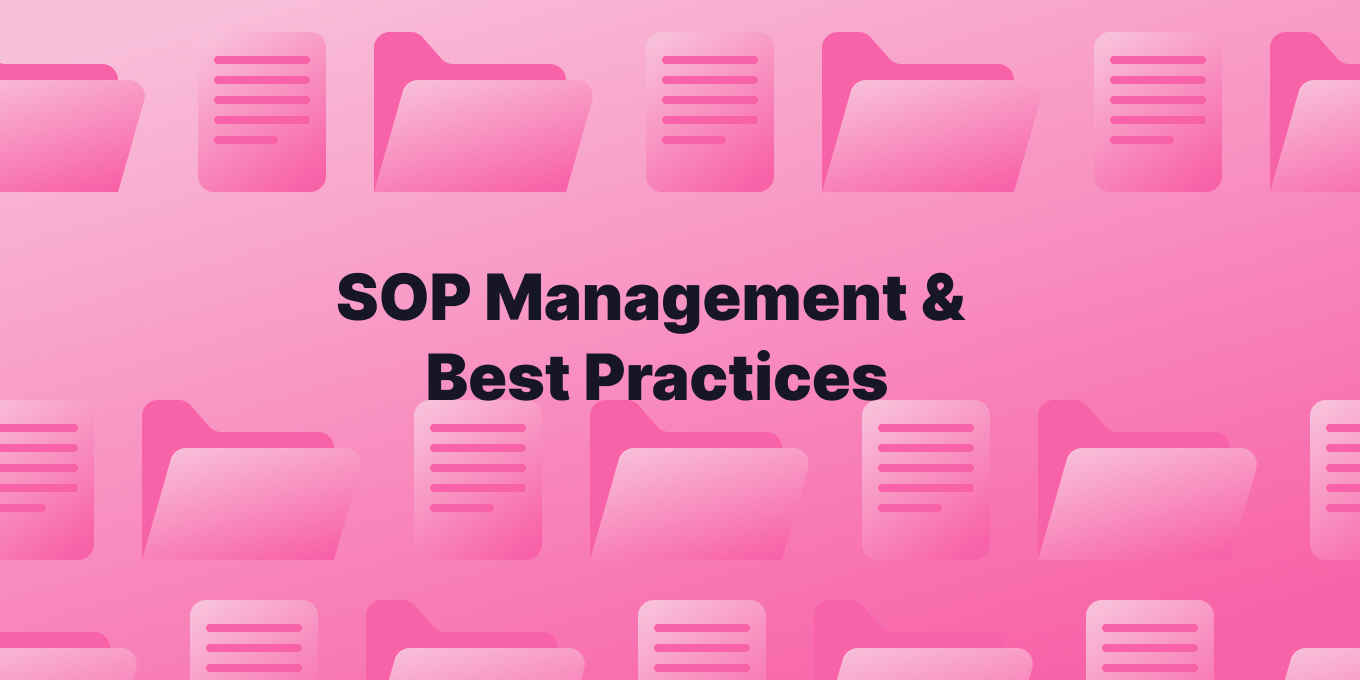If you want a good indication of how a company actually operates day to day, you need only look at their standard operating procedures.
Despite their crucial role within any successful organization, they tend to get a bad reputation.
People often assume that these detailed instructions for routine tasks are just put there to limit employee flexibility, or otherwise babysit workers. In reality, it’s quite the opposite. Standardizing business processes actually frees up an organization, allowing them to repeatedly achieve success in their work. The tricky part is actually writing them.
Coming up with a clear and concise (yet comprehensive) document can be a little daunting.
That’s why we’re going to walk you through how to author the best standard operating procedures – let’s go!
What is a SOP or Standard Operating Procedure?
A standard operating procedure (SOP) is a set of work instructions that describe any steps that need to be taken in order to properly perform an internal business process.
They are step-by-step by definition and so enable anyone to follow along and complete the process, providing they are competent to do so.
It’s a two birds one stone situation because that same nature of SOPs also allows them to be done exactly the same way again and again, thus guaranteeing consistency and compliance.
In fact, you may just hit the entire flock because standard operating procedures do a number of other great things for any company that’s clued-up enough to use them.
By defining a structured and repeatable process for tasks, SOPs ensure that activities are executed with precision, leading to consistent outcomes.
This consistency is crucial for maintaining quality, efficiency, and safety in operations, acting as a guideline for employees to follow.
SOPs also play a vital role in facilitating continuous improvement within organizations. By documenting processes, they provide a basis for reviewing performance and identifying areas for enhancement. This ongoing cycle of evaluation and improvement helps businesses stay competitive and adapt to changing market demands.
Example: Consider a manufacturing company that implements SOPs for its production line. The SOPs detail every step of the assembly process, from the initial setup of machinery to the final quality checks of the finished product. By following these procedures, the company ensures that every unit produced meets its quality standards, thereby reducing the likelihood of defects and customer complaints.
More about SOP software:
Why are SOPs Important? 5 Reasons
SOPs are indispensable for ensuring operational integrity, quality control, and safety in business operations. Their importance cannot be overstated, as they touch every aspect of an organization’s functioning.
1. Consistency and Quality Assurance
SOPs ensure that tasks are performed the same way every time, leading to consistent quality in products and services. This is particularly important in industries where quality control is critical to customer satisfaction and regulatory compliance. Here’s more on customer quality assurance.
2. Efficiency and Productivity
By streamlining operations and reducing the need for decision-making on routine tasks, SOPs free up employees’ time to focus on more strategic activities. This leads to improved productivity and can significantly impact the organization’s bottom line.
3. Safety Standards
In many industries, especially manufacturing and healthcare, SOPs are crucial for maintaining safety standards. They provide clear instructions for handling hazardous materials, operating machinery, and executing potentially dangerous procedures, thereby reducing the risk of accidents and ensuring compliance with safety regulations. Here’s a sample SOP for safety standards.
4. Training and Onboarding
SOPs serve as a valuable training tool for new employees, offering clear guidance on the expectations and procedures of their roles. This can accelerate the onboarding process and ensure new hires are quickly up to speed and contributing to the organization.
5. Continuous Improvement
By documenting the current best practices, SOPs provide a baseline for measuring performance and identifying areas for improvement. Organizations can systematically review and update their SOPs to incorporate new efficiencies, adapt to technological advancements, and respond to changing market conditions. Here’s a sample SOP for maintaining quality standards at a lab.
Example: A technology company implemented SOPs for its software development process, covering everything from code review to bug tracking and customer feedback incorporation. This led to a more efficient development cycle, improved software quality, and higher customer satisfaction, as the team could focus on innovation rather than resolving inconsistencies in their workflow.
The Need for SOPs
SOPs are vital for enhancing the efficiency and effectiveness of organizational operations. They serve as a guide for performing tasks accurately, ensuring that all team members are aligned with the organization’s standards and objectives.
This alignment is crucial for maintaining consistency across operations, adhering to compliance requirements, promoting employee safety, and minimizing waste.
Standard operating procedures & knowledge management
Standard operating procedures (SOPs) are part of your knowledge management arsenal, there to benefit efficiency, consistency, quality of output, internal communication, and compliance with regulations. Here are the areas which can be improved by great SOPs:
- Overall Efficiency: Standardization means you lock in the best way to do processes
- Production Consistency: SOPs are made to be easy to follow and thus repeatable
- Error Reduction: Giving guidance leaves less opportunity for employee fault
- Conflict Resolution: Issues are resolved by a clear roadmap that avoids emotion
- Employee Onboarding: Clear instructions speed up new-hire training
- Health and Safety Guidelines: SOPs are written with employee protection built in
- Liability Limiting: SOPs add accountability and help out during inspections
- Business Value: High-quality SOPs may add value to the business
Whether you’re a small startup or a large corporation, learning how to write SOPs is important if you like the sound of smooth operation and continual improvement.
Identify tasks and complex Processes to document
Understanding and documenting both routine tasks and complex processes within an organization is essential for creating effective SOPs. In industries like agriculture or manufacturing, where processes can vary in complexity, SOPs ensure that every task, from the simple to the intricate, is performed consistently, leading to reliable and high-quality outputs.
Example: A specialty chemical manufacturing company faced challenges with its waste management procedures, leading to environmental compliance issues and operational inefficiencies. By developing SOPs that detailed the process for handling, treating, and disposing of chemical waste, the company not only improved its environmental compliance but also streamlined its waste management process, resulting in cost savings and reduced environmental impact.
Involve relevant employees in developing your SOPs
Engaging employees in the development process ensures that the SOPs are realistic, practical, and reflective of the actual work environment.
Examples:
- Technical Advisers: Their expertise ensures that SOPs are technically accurate and incorporate the latest industry practices.
- Frontline Workers: Including their input guarantees that the SOPs are practical and address the day-to-day challenges they face.
Example: A software development company sought to improve its project management processes. By involving project managers, developers, and QA specialists in the development of SOPs for project initiation, execution, and closure, the company was able to create practical and effective procedures.
This collaborative effort led to improved project timelines, enhanced quality of software products, and increased employee satisfaction as team members felt their expertise and challenges were recognized and addressed.
How do you write a process SOP? (Step-by-Step Instructions)
Now that the relevant context is out of the way, let’s get down to the creation process.
Without sounding too meta, here are the step-by-step instructions for you to follow in order to create step-by-step instructions for people to follow:
1. Note the processes that need an SOP
How does a team of 25 employees get 60 to 70 trucks fueled, 35 to 40 trailers set-up, and the lawn mower blades sharpened in just 20 minutes, all in time to roll out by 7AM?
No, it’s not some high school math question, but rather how landscaping company Outerland (formerly Maffei Companies) used standard operating procedures to complete 29 specific tasks each morning and boost their performance.
Tasks were assigned to specific people and detailed checklists ensured that all of the equipment was where it should be and in working condition.
You don’t have to be a landscaping company to see that virtually anything that a business does repeatedly can and should get its very own SOP. Here are the most commons areas where standard operating procedures can be found helping out:
- Operations: Production steps, equipment inspection, maintenance protocol
- Marketing and Sales: Customer journey mapping, sales pipeline management, press releases, social media, adverts, sales quotes
- Customer Service: Service delivery process, warranties/guarantee policies, customer complaint protocol, feedback systems
- Hiring and Onboarding: Job descriptions, employee orientation, training stages
- Employee Performance: Performance reviews, corrective actions, disciplinary protocol
- Accounts and Finance: Payment cycles, invoices, billing, collections, payment delay protocol, customer data management
- Legal: Privacy policies, regulatory documents, accessibility, liability
There are countless other business processes that can be complemented with standard operating procedures, so it really depends on the best practices your organization is doing on a regular basis.

Get more info about processes & documentation from Tettra
- 15 best online documentation tools
- What is process mapping?
- The top process documentation tools
- Why you need project documentation
- How to build effective product documentation
- How to document your processes
- The types of business process documentation you need
- How good team documentation boosts productivity
2. Determine who will create and implement the SOPs
Just as you find in-house subject matter experts (SME) when creating a knowledge base, you need to find those who are going to be responsible for SOPs.
The same candidates are ideal for both tasks, so look to your department heads, managers, technical advisers, or any employee who has shown exceptional ability with certain process.
It’s imperative to include a variety of roles when creating SOPs in order to generate maximum buy-in from the workforce, encourage employee proactivity, and foster teamwork. Being inclusive also means that you will simply produce better SOPs because you can align company standards with any valuable insight gained from the person most closely connected to the process.
3. Collect the right SOP info for accuracy
In order to create genuinely effective SOPs, you must think of them in terms of the larger world of internal documentation within your business:
- Company Policies: establish the framework for behavior within an organization
- Operational Principles: what values are important to your company and/or team
- Process Document: offers an overarching outlook on a business process.
- SOP: describes steps that need to be taken in order to complete an internal process.
- Technical Instructions: give precise instructions for how specific tasks are completed, such as the detailed operation of a particular machine
- Company Policies: Establish the framework for behavior within an organization
- Operational Principles: What values are important to your company and/or team
- Process Document: Offers an overarching outlook on a business process.
- SOP: Describes steps that need to be taken in order to complete an internal process.
- Technical Instructions: Give precise instructions for how specific tasks are completed, such as the detailed operation of a particular machine
You can think of an SOP as a middle level in this four-tier pyramid (Policy, Process Document, SOP, Technical Instructions). They reflect the company framework and also summarize pertinent process information, such as the equipment needed.
They are essentially ground-level documents, not so general as to be unhelpful but not so technical as to be confusing.
The level of detail provided should be enough to achieve a consistent result without overcomplicating work. In order to stay in this window of detail, you should be explicit about the scope of the SOP so that it only covers the intended process.
At the same time, you should strive to keep the language, style, and format of SOPs in fitting with industry standards. You can try to find examples from similar companies or consult an expert.
4. Test the SOP before full implementation
Trialing a standard operating procedure (SOP) before implementing it in your organization is crucial for a few big reasons.
- It ensures the document accurately reflects the process in question
- You get to see how employees actually interact with the SOP document.
An inaccurate SOP or internal process drives you straight to the things that you set out to avoid, such as confusion, miscommunication, error and overall inefficiency. Here’s what to do before you give the green light:
- Review the existing SOP or document: Start by thoroughly reviewing how things are currently done, who is responsible for each task, and any specific requirements or guidelines that need to be followed. This will serve as a great reference point.
- SOP creation: Write up the document using clear and concise language, provide step-by-step instructions, and include any visuals that help understanding.
- Involve Stakeholders: It’s really important to include stakeholders in the review process, such as department heads and subject matter experts. Getting their input means you can identify any knowledge gaps and/or inconsistencies that require further clarification.
- Conduct a Test: before you do the company-wide rollout, ask a small group of people to follow the SOP and provide feedback. This will help identify the creases that need ironing out before implementation.
Based on the findings from the trial run, you have a great opportunity to refine the SOP. With any luck, you’ll then have the most accurate and effective version to implement throughout your organization.
5. Run regular quality checks on new & existing SOPs
Even when you’ve finished a standard operating procedures document, the work is far from finished.
One of the primary motivations behind writing SOPs is increased efficiency, but you won’t know how successful that endeavor has been unless you conduct regular quality checks. Likewise, you can’t be sure of consistent work without keeping an eye open.
Scheduled reviews of your SOPs helps an organization to identify areas for improvement and adhere to best practices. Of course this applies to brand-new procedures, but also any existing documents you rely on to complete work.
Some internal documentation you can look at are:
- Company Rubrics
- Employee Anecdotes
- Performance Evaluations
- Relevant Feedback Logs
- Quality Control Documents
- Industry Standards Literature
- Previous Version of SOP
It’s important to note that the exact selection of internal documents that you reference when reviewing your own SOPs will vary depending on the specific requirements of your organization, and industry.
6. Follow a reliable SOP format
With an SOP, clarity is even more important because you’re looking for a particular outcome, i.e., the process completed.
The format of an SOP plays a crucial role in how effectively the information is communicated to the end-users. The choice between formats like flowcharts, simple steps, or hierarchical steps should be guided by the nature of the task and the audience’s needs.
Similarly, deciding between digital or hard copy formats involves considering factors like accessibility, ease of updates, and how the SOPs are most frequently used in the workplace.
For complex processes involving multiple decision points, flowcharts can be particularly effective. For instance, an emergency response procedure might be best represented as a flowchart, allowing users to quickly determine their next steps based on the current situation.
Here are just a few tips on how to structure your document:
Select the best SOP format for what you’re trying to do
There are a lot of options when it comes to the actual SOP format, and the one that’s best can depend on all kinds of factors, including industry standards, company philosophy, type of process, and individual preference.
- Step-by-Step List: When the process in question is relatively straightforward, a simple step-by-step written SOP format will usually suffice. These most commonly take form as numbered or bulleted lists that outline each step of a process.
- Example: An SOP for setting up a new employee’s workstation might use bulleted lists to detail the equipment setup, software installations, and security protocols, allowing the IT staff to quickly check off completed tasks.
- Hierarchical List: If the process proves slightly more complicated, where more instructions are required, consider a hierarchical list for your SOP format. Numbered or bulleted points are stepped (1a, 1b) in order to organize greater detail.
- Example: A step-by-step SOP for a software release might include detailed instructions for code submission, review processes, testing protocols, and deployment, with each step outlined in a manner that is easy to follow for team members at all levels of expertise.
- Checklist: When the order of processes isn’t necessarily important, checklist SOPs may prove more flexible and convenient for the employee. This format is particularly well-suited to situations where repetitive tasks are completed quickly, such as a housekeeping checklist.
- Flowchart Format: When multiple outcomes are possible at certain points of the process, flowcharts are a great SOP format. They are a more flexible approach that often require decisions to be made, which influence the final pathway of the process.
- Example: A troubleshooting SOP for network issues might use a flowchart to guide users through a series of diagnostic steps to identify and resolve common problems, with branches for different symptoms leading to tailored solutions.
- Video: When a process is especially challenging, or its nature demands a more visual format, video SOPs can be an effective solution. Demonstrating processes with video footage is perhaps most familiar within the training and onboarding context, and given that around 65% of people are visual learners, it may be a good idea to represent some instruction in this way.
Why do companies have an SOP for writing SOPs?
Good question! Companies have an SOP for writing SOPs to ensure consistency in the style, format, and level of detail of SOP documents. By having a standardized approach, companies can maintain uniformity and ensure that all processes are documented in a consistent manner.
7. Include all necessary SOP document sections
Proper formatting of your standard operating procedure (SOP) is utterly essential to ensure accuracy and readability, both of which are needed for workforce buy-in.
Here’s how you can format your SOP document effectively:
- Table of Contents
- A well-organized table of contents is essential for large SOP documents, enabling users to quickly find the information they need. It should be logically structured, perhaps by department or process type, and include clear headings and subheadings.
- TOC Example: In a manufacturing SOP manual, the table of contents could be organized by production line, with further subdivisions for equipment setup, operation procedures, and shutdown procedures, making it straightforward for employees to locate specific instructions.
- Title and numbering: Begin with a descriptive title that very clearly indicates the process covered. Use a consistent numbering scheme for easy reference.
- Introduction: Briefly explain the purpose and relevance of the document, outlining any key concepts or terminology.
- Objectives: State objectives and expected outcomes of the processes.
- Materials and Equipment: List any required materials, equipment, or tools.
- Step-by-step Instructions: The meat of the document. Break down the process using clear and concise language and pay attention to the order of tasks.
- Visual aids: Present any flowcharts, diagrams, and images as needed.
After this, there are some other elements to consider:
- Safety Precautions: Outline potential hazards, the safety equipment to be used, and any other health and safety considerations or instructions.
- Troubleshooting: Address any common issues that may arise during the process and provide troubleshooting steps to resolve them.
- Glossary: list terminology used throughout SOP for easy reference, which may include acronyms, jargon, and technical terms.
- References: Reference any external documents, industry regulations, and related resources.
Not all SOPs are created equal, but they do all have clear formatting in common.
Remember that the entire point of these documents is to empower employees to do their jobs effectively. Clear structure translates as user-friendliness, which bumps up the likelihood of people actually using the SOP, and your organization benefiting from that.
8. Assign a responsible SOP document owner
Responsible individuals are a big part of any decent knowledge sharing network, and so you won’t be surprised to hear that SOPs docs need owners assigned to them. By adding this level of accountability, you can be confident that the documents are well-maintained and up-to-date.
You may be inclined to jump to the usual suspects – department heads, managers, and team leads – but don’t forget that anyone with an in-depth knowledge of the process can create and manage an SOP.
Providing that the responsible individuals involved are well-organized and have great attention to detail, having a little variety might actually open up your organization to unique insights and speed up improvements.
9. Craft clear instructions for employees
Even though the best standard operating procedures (SOPs) use simple language, the act of writing them requires a lot of planning and precision. That being said, you get a long way by following a structured approach, involving relevant stakeholders, and double-checking all of the information.
Well-written SOPs are corporate rocket fuel.
They drive major improvements, encourage innovation, strengthen the cohesiveness of your team, and optimize the daily operations of employees.
With just a little careful planning, you can massively improve your business, one step-by-step at a time.
By carefully considering the structure and format of SOPs, organizations can create documents that not only meet regulatory and operational requirements but also enhance employee understanding and compliance. Through practical examples and case studies, it’s evident that well-designed SOPs are an invaluable tool for ensuring operational excellence across a wide range of business processes.
Recommended info on SOPs and Standard Operating Procedures
- Best practices for SOP management
- Common business process docs and how to use them
- The best SOP software to try today
- The best SOP formats and templates to use
How to use Tettra for standard operating procedures
Tettra harnesses the power of artificial intelligence to streamline your company’s information management process. With AI, Tettra intelligently curates and organizes crucial company information, transforming it into a comprehensive knowledge base that can be your SOP software.
Advantages of Tettra:
- Consistency and Standardization: By using Tettra to store your standard operating procedures (SOPs), you ensure that your team follows a consistent and standardized approach to tasks. With centralized access to SOPs, everyone can access the most up-to-date versions, minimizing errors and ensuring adherence to best practices.
- Enhanced Efficiency: Tettra enables you to find the information you need quickly, eliminating the need to waste time searching through scattered documents or bothering colleagues with repetitive questions. With Tettra, you can access the knowledge base directly within Slack, streamlining your workflow and boosting productivity.
- Collaborative Environment: Colleagues can contribute their expertise, update information, and suggest improvements, creating a dynamic environment that promotes continuous learning and growth.





